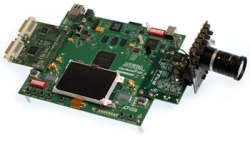Mar 26 2010
Apical Ltd and Altera Corporation have pioneered the development of a wide dynamic range (WDR), high definition (HD) CMOS image sensor-processing system for use in video-surveillance cameras.
 Altera's New Video Surveillance Camera Reference Design
Altera's New Video Surveillance Camera Reference Design
The system will be showcased during March 24 to 26, 2010 at the International Security Conference (ISC) West Expo in Las Vegas. The system guarantees excellent quality of the video image irrespective of changing light conditions that posed a major hurdle for previously used surveillance cameras.
Brightness level that ranges broadly from low light to sunlight is the major limitation for traditional CMOS image sensors, resulting in wash out or black out of video subjects. This limitation can be overcome by WDR CMOS sensors, though it poses a design challenge. It involves the generation of huge quantity of data, up to 20 bits per color and 1.2 Mpix at 60 frames a second. This data has to be processed within the image sensor pipeline (ISP) and cannot be processed on-chip. The ASSPs and DSPs currently used in surveillance systems usually cannot perform the large number-crunching algorithms, which is possible using Cyclone FPGAs from Altera, used for transforming the raw image to a standard digital output for generating a video image with high clarity.
Apical has provided the capability to embed the sensor-processing feature in its Cyclone FPGA. Apical’s IP incorporates the complete ISP that performs the auto-white, auto-gain, and auto-exposure functions. These functions result in clear video images in both bright-light and low-light conditions. This IP includes Apical’s latest iridix local tone mapping engine for optimizing video images. The engine imitates the human eye, along with advanced color processing and enhanced 2D or 3D noise reduction. The Cyclone III and Cyclone IV ranges of the FPGA carry out these functions, along with power consumption, logic utilization, and clock rates capabilities that are unsurpassed in the industry.
Michael Tusch, Apical’s CEO, revealed in the past sensors were not able to perform well in both bright-light or low-light conditions, though they could do well in either of the two conditions. The new development now ensures that these sensors perform equally well in extreme light conditions. Tusch explained that when Apical found that DSPs were not able to provide the desired functions, they considered using Cyclone FPGAs of Altera since they provided the required performance for running Apical’s IP for meeting the power and cost point restrictions imposed by the surveillance market.
Michael Samuelian, Altera’s director of the industrial and automotive business unit, revealed that FPGAs of Altera empower customers to achieve more using their designs, particularly for the industrial market where customary ASSPs and DSPs have reached their saturation point. Samuelian explained that Altera’s low power and low cost Cyclone range of FPGAs are used as the key image-processing component right from image capture to display. Samuelian added that Altera’s IP and FPGA’s will enable the state-of-the-art video surveillance systems with limitless potential to be introduced in market sooner.